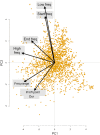Determinants of variability in signature whistles of the Mediterranean common bottlenose dolphin
- PMID: 35618794
- PMCID: PMC9135725
- DOI: 10.1038/s41598-022-10920-7
Determinants of variability in signature whistles of the Mediterranean common bottlenose dolphin
Abstract
One of the most studied aspects of animal communication is the acoustic repertoire difference between populations of the same species. While numerous studies have investigated the variability of bottlenose dolphin whistles between populations, very few studies have focused on the signature whistles alone and the factors underlying differentiation of signature whistles are still poorly understood. Here we describe the signature whistles produced by six distinct geographical units of the common bottlenose dolphin (Tursiops truncatus) in the Mediterranean Sea and identify the main determinants of their variability. Particularly, the influence of the region (proxy of genetic distance), the geographic site, and the environmental (sea bottom-related) and demographical (population-related) conditions on the acoustic structure of signature whistles was evaluated. The study provides the first evidence that the genetic structure, which distinguishes the eastern and western Mediterranean bottlenose dolphin populations has no strong influence on the acoustic structure of their signature whistles, and that the geographical isolation between populations only partially affected whistle variability. The environmental conditions of the areas where the whistles developed and the demographic characteristics of the belonging populations strongly influenced signature whistles, in accordance with the "acoustic adaptation hypothesis" and the theory of signature whistle determination mediated by learning.
© 2022. The Author(s).
Conflict of interest statement
The authors declare no competing interests.
Figures








Similar articles
-
Identification and characteristics of signature whistles in wild bottlenose dolphins (Tursiops truncatus) from Namibia.PLoS One. 2014 Sep 9;9(9):e106317. doi: 10.1371/journal.pone.0106317. eCollection 2014. PLoS One. 2014. PMID: 25203814 Free PMC article.
-
Bottlenose dolphins exchange signature whistles when meeting at sea.Proc Biol Sci. 2012 Jul 7;279(1738):2539-45. doi: 10.1098/rspb.2011.2537. Epub 2012 Feb 29. Proc Biol Sci. 2012. PMID: 22378804 Free PMC article.
-
Whistle discrimination and categorization by the Atlantic bottlenose dolphin (Tursiops truncatus): a review of the signature whistle framework and a perceptual test.Behav Processes. 2008 Feb;77(2):243-68. doi: 10.1016/j.beproc.2007.11.002. Epub 2007 Nov 13. Behav Processes. 2008. PMID: 18178338 Review.
-
Vocal universals and geographic variations in the acoustic repertoire of the common bottlenose dolphin.Sci Rep. 2021 Jun 4;11(1):11847. doi: 10.1038/s41598-021-90710-9. Sci Rep. 2021. PMID: 34088923 Free PMC article.
-
The Gulf of Ambracia's Common Bottlenose Dolphins, Tursiops truncatus: A Highly Dense and yet Threatened Population.Adv Mar Biol. 2016;75:259-296. doi: 10.1016/bs.amb.2016.07.002. Epub 2016 Aug 25. Adv Mar Biol. 2016. PMID: 27770987 Review.
Cited by
-
The Acoustic Ecology of Coastal Dolphins by Assessing the Structural Variability of Sounds and the Influence of Contextual Factors.Integr Zool. 2025 Jul;20(4):686-699. doi: 10.1111/1749-4877.12934. Epub 2024 Dec 13. Integr Zool. 2025. PMID: 39672673 Free PMC article.
-
First acoustic evidence of signature whistle production by spinner dolphins (Stenella longirostris).Anim Cogn. 2023 Nov;26(6):1915-1927. doi: 10.1007/s10071-023-01824-8. Epub 2023 Sep 7. Anim Cogn. 2023. PMID: 37676587
-
Investigating the presence of different bottlenose dolphin ecotypes in the Mediterranean Sea.Sci Rep. 2025 Feb 14;15(1):5526. doi: 10.1038/s41598-025-88605-0. Sci Rep. 2025. PMID: 39952977 Free PMC article.
-
Assessing an acoustic bioindicator of leisure boating disturbance on bottlenose dolphins.PeerJ. 2025 Aug 1;13:e19726. doi: 10.7717/peerj.19726. eCollection 2025. PeerJ. 2025. PMID: 40761806 Free PMC article.
References
-
- Wei C. Sound production and propagation in cetacean. In: Rosenfeld CS, Hoffmann F, editors. Neuroendocrine Regulation of Animal Vocalization. Academic Press; 2021. pp. 267–291.
-
- Nakakara F. Social functions of cetacean acoustic communication. Fish. Sci. 2002;68:298–301. doi: 10.2331/fishsci.68.sup1_298. - DOI
-
- Caldwell MC, Caldwell DK, Tyack PL. Review of the signature-whistle-hypothesis for the Atlantic bottlenose dolphin. In: Leatherwood S, Reeves RR, editors. The bottlenose dolphin. Academic Press; 1990. pp. 199–234.
MeSH terms
LinkOut - more resources
Full Text Sources

